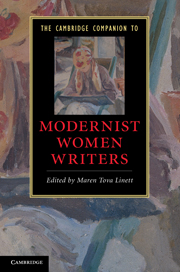Book contents
- Frontmatter
- Modernist women’s literature: an introduction
- 1 Transforming the novel
- 2 Modernist women poets and the problem of form
- 3 Women’s modernism and performance
- 4 Magazines, presses, and salons in women’s modernism
- 5 Gender in women’s modernism
- 6 Black women’s modernist literature
- 7 Race and ethnicity in white women’s modernist literature
- 8 Geomodernism, postcoloniality, and women’s writing
- 9 Women modernists and visual culture
- 10 Modernism and trauma
- 11 Political activism and women’s modernism
- 12 Religion and the occult in women’s modernism
- Guide to further reading
- Index
8 - Geomodernism, postcoloniality, and women’s writing
Published online by Cambridge University Press: 28 November 2010
- Frontmatter
- Modernist women’s literature: an introduction
- 1 Transforming the novel
- 2 Modernist women poets and the problem of form
- 3 Women’s modernism and performance
- 4 Magazines, presses, and salons in women’s modernism
- 5 Gender in women’s modernism
- 6 Black women’s modernist literature
- 7 Race and ethnicity in white women’s modernist literature
- 8 Geomodernism, postcoloniality, and women’s writing
- 9 Women modernists and visual culture
- 10 Modernism and trauma
- 11 Political activism and women’s modernism
- 12 Religion and the occult in women’s modernism
- Guide to further reading
- Index
Summary
In his brief “Note on Modernism” in Culture and Imperialism, Edward Said describes canonical Anglo-European modernism as an aesthetic attempt to contain the crises of early twentieth-century imperialist capitalism. He closes his short discussion with the suggestion that modernist styles arise “as more and more regions - from India to Africa to the Caribbean - challenge the classical empires and their cultures.” Although later in Culture and Imperialism Said considers scenes of anti-colonial resistance in texts such as E. M. Forster's Passage to India, he never fully develops the implications of his note about the relation between anti-colonial insurgency and the appearance of modernism. These implications are far-reaching: in fact they point toward a deep revision of the paradigm in which we read twentieth-century modernist and postcolonial literature in English. This chapter explores some of those implications, building on recent work in modernist studies. I describe the ways that not only colonialism but also anti-colonialism, and not only slavery and racism but also anti-slavery, have constituted world conditions since the late eighteenth century, and I suggest that a history of insurgency and global conflict provokes what can thus be called the “geomodernist” practices of diverse artists from the late nineteenth to the twenty-first century.
- Type
- Chapter
- Information
- The Cambridge Companion to Modernist Women Writers , pp. 129 - 145Publisher: Cambridge University PressPrint publication year: 2010
- 4
- Cited by

